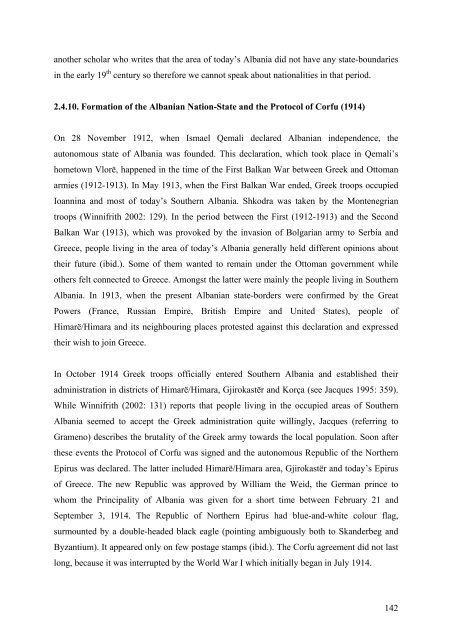university of nova gorica graduate school contested spaces and ...
university of nova gorica graduate school contested spaces and ...
university of nova gorica graduate school contested spaces and ...
You also want an ePaper? Increase the reach of your titles
YUMPU automatically turns print PDFs into web optimized ePapers that Google loves.
another scholar who writes that the area <strong>of</strong> today’s Albania did not have any state-boundaries<br />
in the early 19 th century so therefore we cannot speak about nationalities in that period.<br />
2.4.10. Formation <strong>of</strong> the Albanian Nation-State <strong>and</strong> the Protocol <strong>of</strong> Corfu (1914)<br />
On 28 November 1912, when Ismael Qemali declared Albanian independence, the<br />
autonomous state <strong>of</strong> Albania was founded. This declaration, which took place in Qemali’s<br />
hometown Vlorë, happened in the time <strong>of</strong> the First Balkan War between Greek <strong>and</strong> Ottoman<br />
armies (1912-1913). In May 1913, when the First Balkan War ended, Greek troops occupied<br />
Ioannina <strong>and</strong> most <strong>of</strong> today’s Southern Albania. Shkodra was taken by the Montenegrian<br />
troops (Winnifrith 2002: 129). In the period between the First (1912-1913) <strong>and</strong> the Second<br />
Balkan War (1913), which was provoked by the invasion <strong>of</strong> Bolgarian army to Serbia <strong>and</strong><br />
Greece, people living in the area <strong>of</strong> today’s Albania generally held different opinions about<br />
their future (ibid.). Some <strong>of</strong> them wanted to remain under the Ottoman government while<br />
others felt connected to Greece. Amongst the latter were mainly the people living in Southern<br />
Albania. In 1913, when the present Albanian state-borders were confirmed by the Great<br />
Powers (France, Russian Empire, British Empire <strong>and</strong> United States), people <strong>of</strong><br />
Himarë/Himara <strong>and</strong> its neighbouring places protested against this declaration <strong>and</strong> expressed<br />
their wish to join Greece.<br />
In October 1914 Greek troops <strong>of</strong>ficially entered Southern Albania <strong>and</strong> established their<br />
administration in districts <strong>of</strong> Himarë/Himara, Gjirokastër <strong>and</strong> Korça (see Jacques 1995: 359).<br />
While Winnifrith (2002: 131) reports that people living in the occupied areas <strong>of</strong> Southern<br />
Albania seemed to accept the Greek administration quite willingly, Jacques (referring to<br />
Grameno) describes the brutality <strong>of</strong> the Greek army towards the local population. Soon after<br />
these events the Protocol <strong>of</strong> Corfu was signed <strong>and</strong> the autonomous Republic <strong>of</strong> the Northern<br />
Epirus was declared. The latter included Himarë/Himara area, Gjirokastër <strong>and</strong> today’s Epirus<br />
<strong>of</strong> Greece. The new Republic was approved by William the Weid, the German prince to<br />
whom the Principality <strong>of</strong> Albania was given for a short time between February 21 <strong>and</strong><br />
September 3, 1914. The Republic <strong>of</strong> Northern Epirus had blue-<strong>and</strong>-white colour flag,<br />
surmounted by a double-headed black eagle (pointing ambiguously both to Sk<strong>and</strong>erbeg <strong>and</strong><br />
Byzantium). It appeared only on few postage stamps (ibid.). The Corfu agreement did not last<br />
long, because it was interrupted by the World War I which initially began in July 1914.<br />
142

















